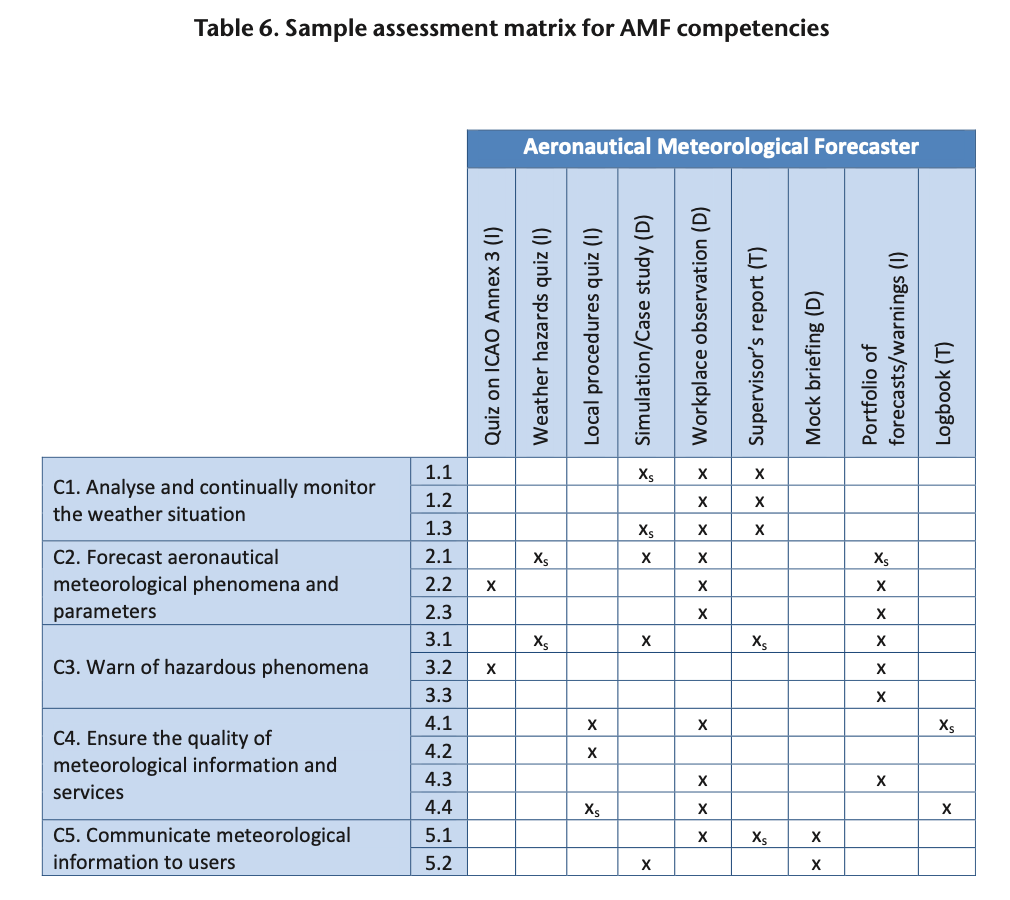Steps in planning and conducting the competency assessment planning process
As described in the Aviation Competency Assessment Toolkit, the planning and design phase for creating a customized competency assessment plan should include the following steps:
- Determine who will manage the planning and implementation, and who will be part of the planning team.
- Identify the competency framework performance criteria that fit the current job/position in your country/organization. Strongly consider making changes to the job/position description to account for the international competency standards. Add
any additional criteria, if necessary, based on local procedures and conditions. The result of this step is the first step in an Assessment Matrix as displayed in the first column of Toolkit 1 of this assessment toolkit website.
-
Determine the tools that will be used to assess each of the performance criteria. An example of this is provided in the excerpt from WMO-No. 1205 below.
-
Provide guidance on how the tools will be applied, including a checklist of evidence of competency. This is particularly important for an assessment tools new to the organisation.
-
Determine how you will manage the process:
- Determine the competency improvement methods you will use to help those assessed as "not yet competent."
-
Seek sources of competency assessment training if you decide this is required to better prepare assessors. This toolkit is a starting point, but also see WMO-No. 1205. WMO or your national organization may be able to recommend other sources.
-
Plan a schedule for when the assessment will be conducted and how how much time will be allotted. Determine the number of sites where assessment should take place and the number of persons that must be assessed.
-
Communicate this plan with upper management or government administration as appropriate.
- Decide how records of results will be kept.
- Conduct the assessment.
- Collect and report results.
- Implement competency improvement methods for those staff members that require it.
WMO-No. 1205 offers much more guidance on the assessment process in section 2.2. It is available in English, French, Spanish, Russian, Chinese, and Arabic.
Assessment Matrix example for aviation forecaster competencies from WMO-No. 1205. A descriptive text excerpt is provided below the table.
 |
Text Excerpt:
"Once the assessment tools have been
established, it is good practice to map them back to the performance criteria.
Table 6 provides an example of assessment tools used in competency assessments
of Aeronautical Meteorological Forecasters (AMF) in Australia, and how they map
back to the elements of competency.
Ideally, each performance criterion
should be assessed at least twice to demonstrate that the forecaster can apply
the skills and knowledge in a variety of contexts. More than three assessment
tasks for one performance criterion may be considered redundant. In a small
organization, using two assessment tools might be difficult unless one of them
requires less effort, such as existing or extended supervisor’s reports.
Evidence is defined as direct (D), indirect
(I), or third-party (T); x denotes the main evidence gathering activity, while
xs denotes a supplementary
activity that may be required as a backup if sufficient evidence is not
collected."
- - - - -
Some additional details on assessment planning from WMO-No. 1205 and from the Aviation Competency Assessment Toolkit are provided below:
-
Decide what reasonable adjustments may be applied in special situations (disabilities, work location, operational tools available to the person assessed, travel required and stresses and costs this entails, language and culture of the person
assessed). See WMO-No. 1205, section 2.2.5 for more details.
Recall that a competency framework outlines the minimum skills, knowledge and behaviours personnel need to demonstrate to perform the job function. Once competency has been demonstrated, it needs to be maintained over time and, ideally, organizations
should implement strategies to enhance performance once the minimum requirement is met.
The process of maintaining and developing competency should be documented. For example, how often competency reassessment will occur, what assessment tools will be used, how they will vary from the initial assessment, how and when the organization
will provide training to develop skills and knowledge and how this will be monitored.